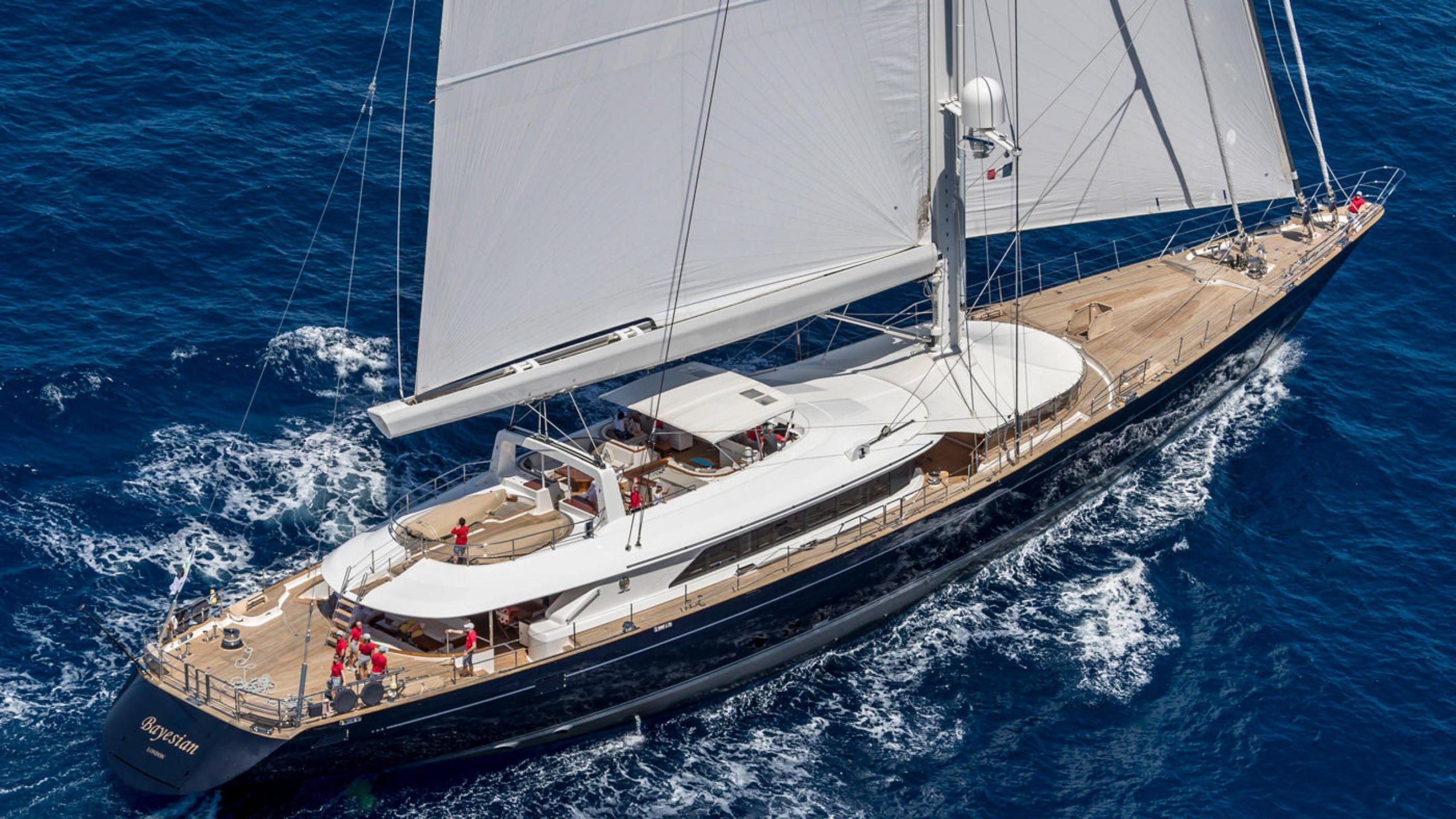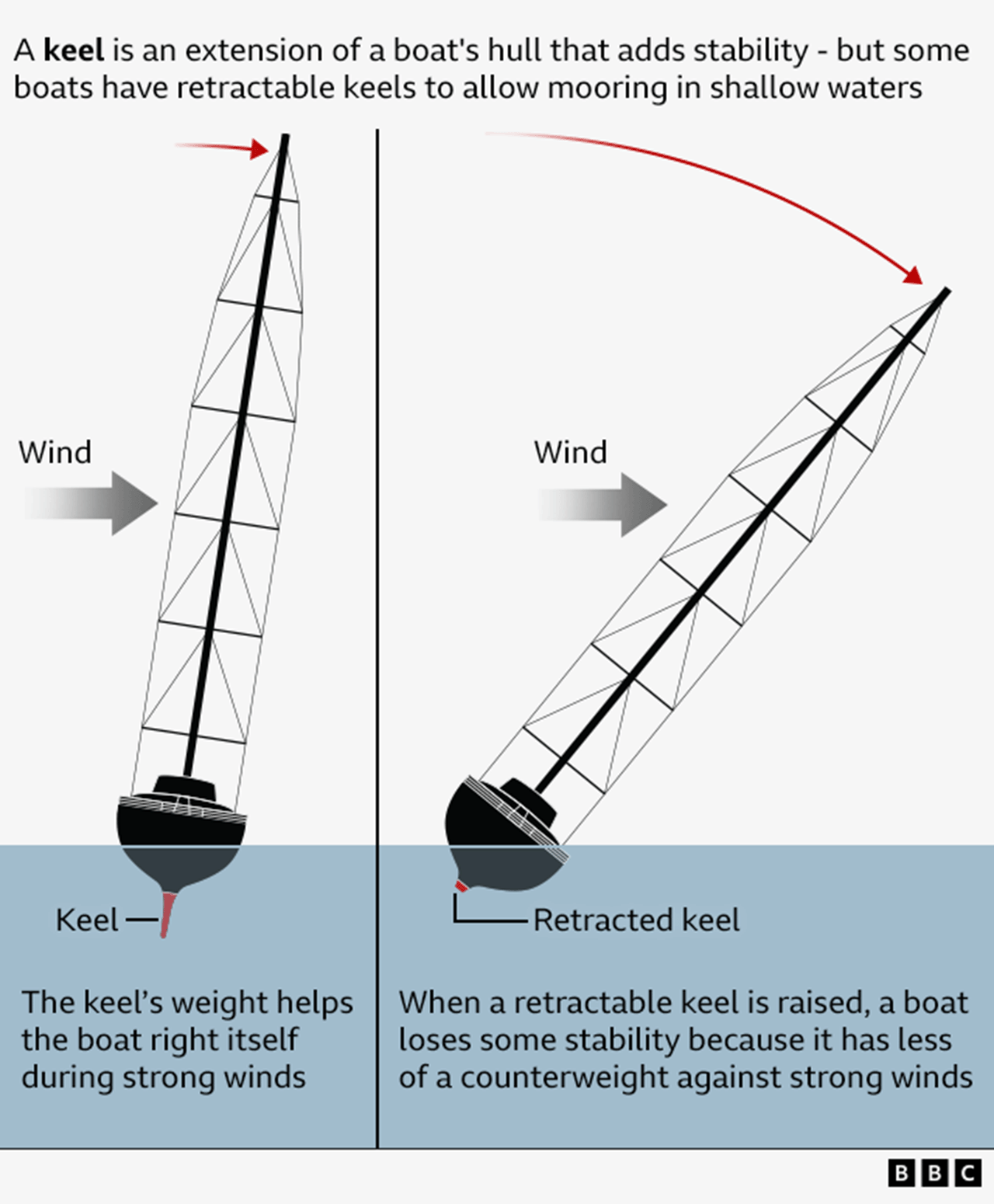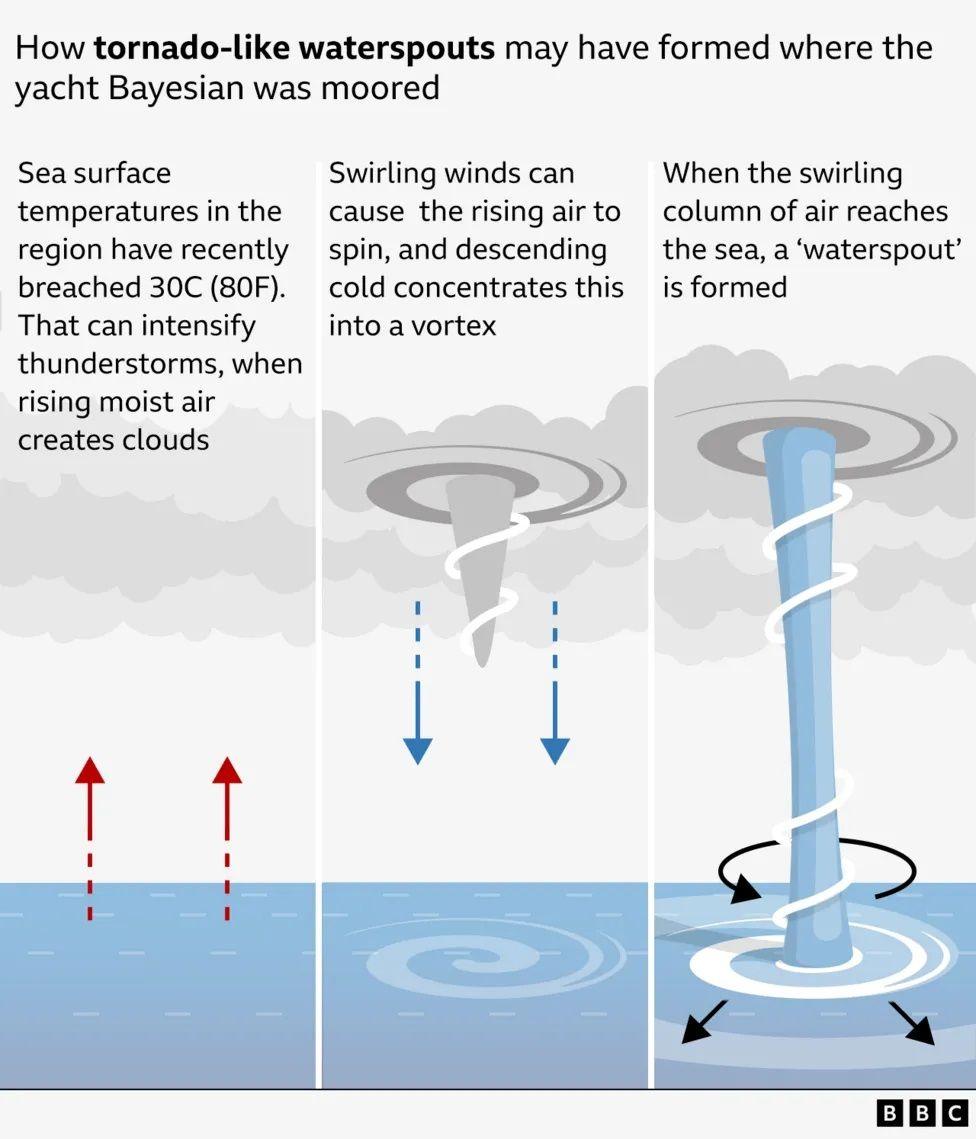Bayesian sinking: The key questions for investigators

Seven people have been confirmed dead after the Bayesian sank off the coast of Palermo, Sicily
- Published
It will be a long time before we get answers as to exactly how the UK-flagged Bayesian yacht sank off the coast of Sicily.
The luxury superyacht was carrying 22 people when a heavy storm that created waterspouts struck early on Monday 19 August.
Seven bodies have been recovered from the wreck of the boat.
As Italian authorities continue to investigate the circumstances around the incident, speculation has swirled about what went wrong, with fingers being pointed at the captain, the crew, and faults with the yacht itself.
But experts have told the BBC that this was likely a "black swan" occurrence of freak weather - and that no-one is necessarily at fault.
Here are the key questions that investigators will be asking as they look into the tragedy.
Was the keel up? And if so, why?
The role of the boat's keel will be closely examined by investigators.
A keel is a large, fin-like part of the boat that protrudes from its base.
The bottom of the keel - which is the lowest part of the boat - contains a huge weight, the bulb, which keeps the boat stable. When the wind pushes the boat onto its side, the keel rises through the water until - like a see-saw - the weight of it pushes the boat back level.
On a boat the size of the Bayesian, keels are often designed to be retracted so that the vessel can dock in areas that aren’t as deep, like a harbour.
When the keel is raised, it makes the boat much less stable.

In this case, the wreck of the Bayesian was found at a depth of 50m (164ft), which suggests there was no reason that the keel needed to be retracted.
But that doesn’t mean the captain or crew were at fault.
"Even without the keel completely out, the ship is stable and only a massive entry of water could have caused the sinking,” a spokesperson for Italian Sea Group, which owns the company that built the Bayesian, said, according to the Telegraph.
Investigators will want to know whether the keel was “up, down or somewhere halfway,” says Jean-Baptiste Souppez, fellow of the Royal Institution of Naval Architects and editor-in-chief of the Journal of Sailing Technology.
What measures did the crew take?
The Captain of the Bayesian, James Cutfield, reportedly told Italian media that he couldn't have foreseen the storm which battered the Bayesian.
But we do know that bad weather had been forecast beforehand.
Luca Mercalli, the president of the Italian Meteorological Society, said on Tuesday that the crew should have made sure that all the guests were awake and assigned them lifejackets, given the poor forecast.
One survivor reportedly told medical staff that the ship started sinking just two minutes after she fell asleep.
Bad weather is one thing, but a waterspout is something else entirely. And not something that the crew could have predicted.
One expert at the scene in Sicily told Reuters news agency an early focus of the investigation would be on whether the yacht’s crew had failed to close access hatches before the bad weather struck.
But on a boat of this size, open hatches alone would likely not have been enough to make the Bayesian sink, experts say.
There are also other entry points for water around the boat known as "down-flooding points", which are there to allow the engine room to be ventilated, among other things.
“There will obviously be questions about the crew and what happened and whether they were prepared,” says Mr Souppez.
“But think it's important to remember that the vessel sank in a matter of minutes, and so actually in the middle of the night for the crew to be able to keep so many people on board alive, deploy the flare, and act in the heat of the moment is a tough task,” he says.
“It is very difficult to say precisely what happened here," said Dr Paul Stott, fellow of the Royal Institute of Naval Architects.
"But it is unlikely that the crew could have reacted in any way to save the yacht in the face of such a sudden and catastrophic weather event."
Approached by BBC News, the Italian police confirmed an investigation was ongoing but no charges have yet been brought.
The yacht's captain, James Cutfield, his eight surviving crew members and passengers have been questioned by the Coast Guard on behalf of prosecutors.
In cases like this one, it is common for officials to embark on a broad investigation - known as a 'crime hypothesis' - that considers a series of possible criminal charges.
How did the boat sink so quickly?
A doctor treating survivors said the ship "capsized within a few minutes".
A key question is how exactly that happened - and how it happened so fast.
“For the vessel to sink, especially at that speed, you are looking at water making its way inside the vessel throughout its entire length”, says Mr Souppez.
“Vessels like this are not actually designed to stand any period of time at 90 degrees,” says Mr Souppez.
“So if the vessel found itself at 90 degrees, then you would expect water to get inside regardless of whether hatches were open or not. Though it would obviously speed up the process.”
Some have speculated that a waterspout flying over the Bayesian could have been "popped" by the mast, dumping a huge amount of water onto the boat - and sinking it rapidly.
Did weather cause freak accident?
Witnesses have described seeing a waterspout form during the storm before the sinking of the Bayesian.
Most are familiar with what tornadoes look like - they are rotating columns of destructive winds, protruding from the base of clouds down to the ground.
According to BBC Weather, waterspouts are just that too, but are over water rather than land. With sea temperatures rising due to climate change, there is a concern that they could become more common.
According to the International Centre for Waterspout Research, there were 18 confirmed waterspouts off the coast of Italy on 19 August alone.
But the chance of one striking a ship directly - as has been speculated could have happened here - is still very low.
“I think that the bottom line will be that even if there have been issues with keel or hatches being open, you are probably still looking at a freak weather accident,” says Mr Souppez.
“This is likely to be a very safe modern design that has met with a freak weather condition for which nothing is designed for,” says Mr Stott.

Related topics
Read more
- Published23 August 2024
